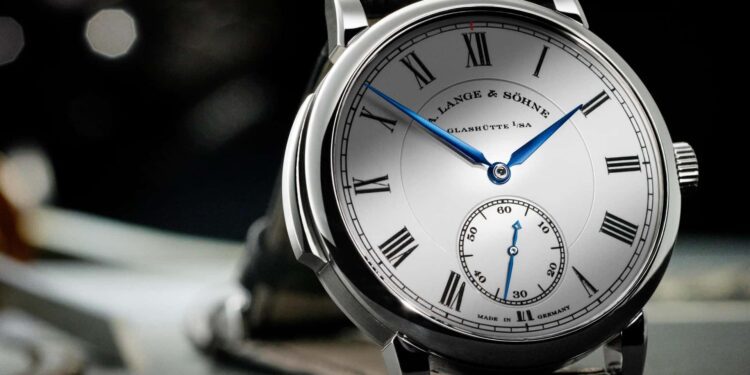Deemed one of the most revered and beloved complicated timepieces in the world, chiming watches actually sound the time using a series of gongs and hammers that work in unison for har- monious allure. There are several types, but the most well-known are minute repeaters, activated by a slide or pusher on the side of the case, and sonneries, which traditionally chime every hour without requiring activation, though they are equipped with a silence button.
Minute repeaters chime the hours, quarter hours, and minutes past the quarter-hour using different tones and combinations of tones. Usually, the hours utilize a low-pitched note, then a combination of a low- and high-pitched notes sound the quarter hours, and a high-pitched tone rings out the minutes past the quarter-hour. Similarly, decimal repeaters chime the hours and every 10-minute interval, and five-minute repeaters do the same with five-minute increments.

Patek Philippe
Chiming watches date back to the clock towers of the 15th century that would strike the hours to let the townspeople know the time. Later, 18th-century chiming clocks were developed for royalty and the wealthy, so they could decipher the time in the dark without rising to light an oil lamp. Today, chiming watches are among the most difficult watches to build, generally housing hundreds of tiny mechanical parts that all work together to not only track the time, but also to make music of it. The movements inside are a complex labyrinth of gears, wheels, springs, barrels, and other components, with the most important parts being hammers and gongs. While most watches use one or two hammers, some of the ultimate haute horological pieces can have three or more hammers and gongs.
So, how does a repeater work? Essentially, a tensioning spring arms the repeater when the wearer presses a lever on the case side. It immediately comes to life, sending the exact time information to a series of racks, cams, and levers that activate the hammer(s) to hit the gong(s), wrapped around the periphery of the watch movement. In the past, those gongs were made of metal, as were the hammers, but recently the top watch brands that produce repeaters have been turning to sapphire crystal to create an even purer sound.

Chopard
Easily one of the most challenging feats when it comes to building the movements of these acoustical beauties is getting the sound right. When the hammers hit the gongs, they must have the perfect reverberation to produce the right loudness, pitch, and length of tone. While the shape, material, weight, hardness, and number of hammers and gongs play an important role here, the human ear is also vital. In the end, if the sound doesn’t sound right to the master watchmaker, it goes back to the drawing board.
Because it generally takes a single watchmaker anywhere from 200 to 300 hours to assemble and tune a minute repeater movement, these watches are not only incredibly rare, but also — rightfully so — among the most expensive in the world.

A. Lange & Söhne
The 39-millimeter Richard Lange Minute Repeater by A. Lange & Söhne was several years in the making as the brand worked to perfect the sound of this 50-piece limited-edition platinum watch. Two differently tuned gongs can strike 720 sequences. The all-new 415-part movement is manually wound and offers 72 hours of power reserve. Price on request.

Jaeger-LeCoultre
Jaeger-LeCoultre is a master at chiming watches, having designed its first one in 1870 and produced more than 200 chiming watch calibers since. This Master Grande Tradition Caliber 950 features a perpetual calendar with moon phases as well as the repeater. The self winding movement consists of 585 parts. It is crafted in 18-karat white gold. Price on request.

Patek Philippe
From the Patek Philippe Grand Complications collection, the 38-millimeter Ref. 5078 G minute repeater is crafted in 18-karat white gold and houses a self-winding mechanical movement. The dial is black enamel in a unique design of scrolls and arabesques. President of the brand, Thierry Stern, listens to every chiming watch before it can be offered to the customer. Price on request.

Audemars Piguet
The Code 11.59 Minute Repeater Super Sonnerie by Audemars Piguet houses the brand’s 362-part hand-wound Caliber 2953 with Supersonnerie sound technology that was eight years in the making (and debuted originally in 2016). Crafted in gold, it features a ceramic octagonal case middle and smoked sapphire dial that allows for an almost secretive look at the movement. Approximately $352,000.

H. Moser & Cie.
From independent Swiss brand H. Moser & Cie., the 40-millimeter Endeavour Concept Minute Repeater Tourbillon Aqua Blue is crafted in 5N 18-karat rose gold featuring a fumé grand feu enamel dial with aperture for viewing the double hammers of the hand-wound movement. The watch features a sliding bolt with Teflon runner that activates the repeater. Only 20 will be made. $365,000.
Story Featured In Our April 2023 Issue













